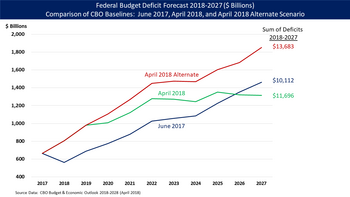Baseline (budgeting)
They are not forecasts of actual budget outcomes, since the Congress will undoubtedly enact legislation that will change revenues and outlays.
That act required the Office of Management and Budget (OMB) to prepare projections of federal spending for the upcoming fiscal year based on a continuation of the existing level of governmental services.
Today's baseline budget projections are very much like those prepared more than two decades ago, although they now span 10 years instead of five.
The Budget Act was silent on whether to adjust estimates of discretionary appropriations for anticipated changes in inflation.
The reconciliation instructions contained in the fiscal year 1982 budget resolution (the so-called Gramm-Latta budget) required House and Senate committees to reduce outlays by a total of $36 billion below baseline levels, but each committee could determine how those savings were to be achieved.
The CBO baseline has been used in every year since 1981 for developing budget resolutions and measuring compliance with reconciliation instructions.
The Balanced Budget and Emergency Deficit Control Act of 1985 provided the first legal definition of baseline.
